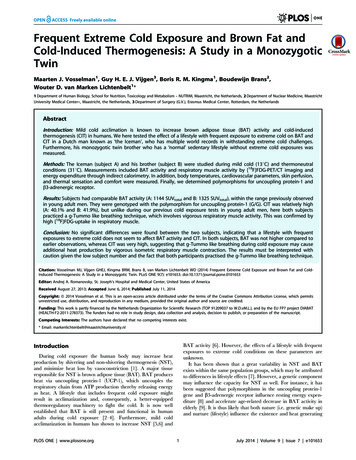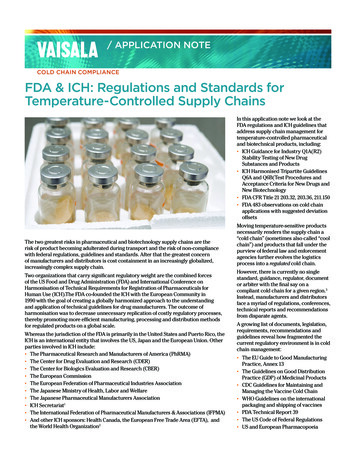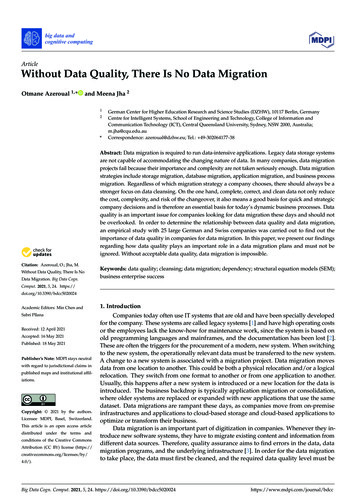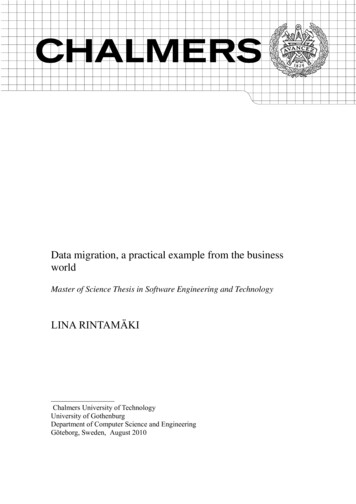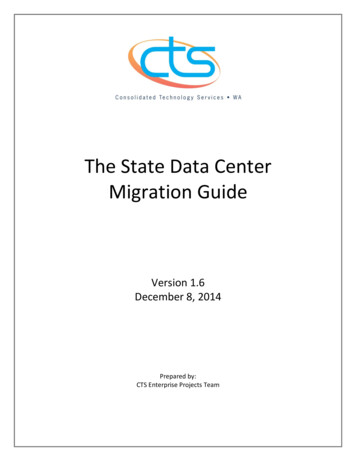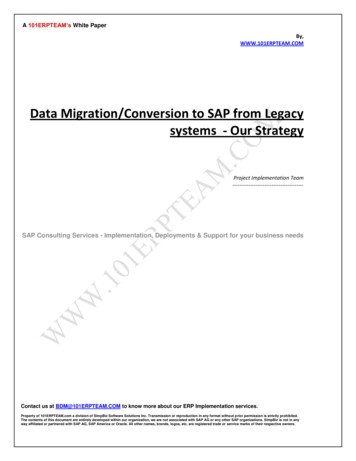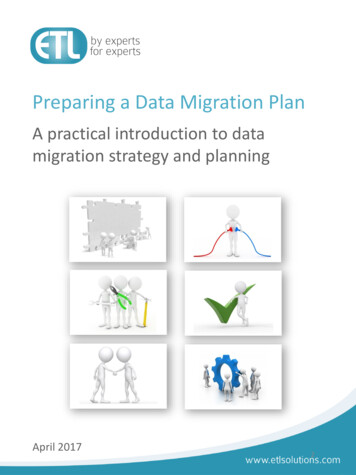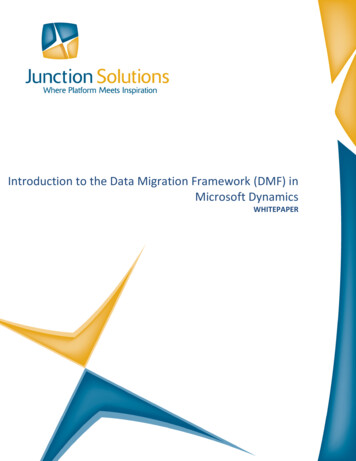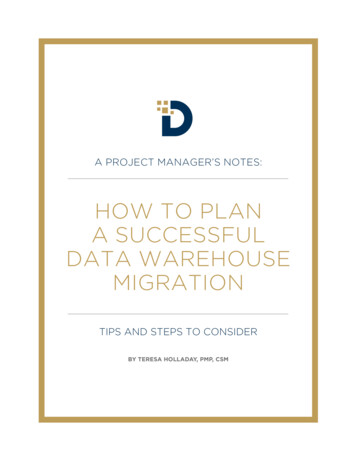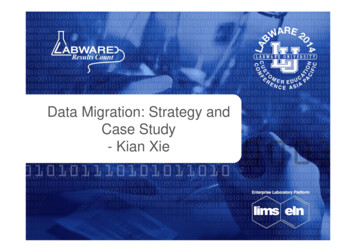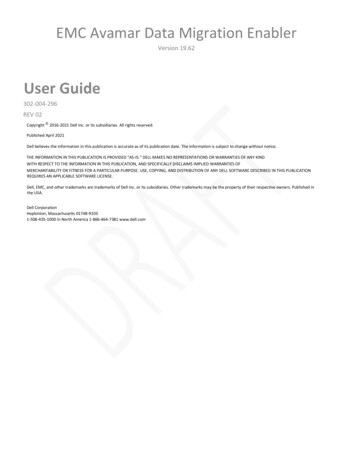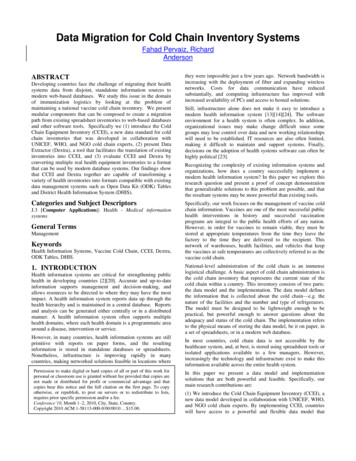
Transcription
Data Migration for Cold Chain Inventory SystemsFahad Pervaiz, RichardAndersonABSTRACTDeveloping countries face the challenge of migrating their healthsystems data from disjoint, standalone information sources tomodern web-based databases. We study this issue in the domainof immunization logistics by looking at the problem ofmaintaining a national vaccine cold chain inventory. We presentmodular components that can be composed to create a migrationpath from existing spreadsheet inventories to web-based databasesand other software tools. Specifically we (1) introduce the ColdChain Equipment Inventory (CCEI), a new data standard for coldchain inventories that was developed in collaboration withUNICEF, WHO, and NGO cold chain experts, (2) present DataExtractor (Dextra), a tool that facilitates the translation of existinginventories into CCEI, and (3) evaluate CCEI and Dextra byconverting multiple real health equipment inventories to a formatthat can be used by modern database systems. Our findings showthat CCEI and Dextra together are capable of transforming avariety of health inventories into formats compatible with existingdata management systems such as Open Data Kit (ODK) Tablesand District Health Information System (DHIS).Categories and Subject DescriptorsJ.3 [Computer Applications]: Health - Medical informationsystemsGeneral TermsManagementKeywordsHealth Information Systems, Vaccine Cold Chain, CCEI, Dextra,ODK Tables, DHIS.1. INTRODUCTIONHealth information systems are critical for strengthening publichealth in developing countries [2][20]. Accurate and up-to-dateinformation supports management and decision-making, andallows resources to be directed to where they may have the mostimpact. A health information system reports data up through thehealth hierarchy and is maintained in a central database. Reportsand analysis can be generated either centrally or in a distributedmanner. A health information system often supports multiplehealth domains, where each health domain is a programmatic areaaround a disease, intervention or service.However, in many countries, health information systems are stillprimitive with reports on paper forms, and the resultinginformation is stored in standalone databases or spreadsheets.Nonetheless, infrastructure is improving rapidly in manycountries, making networked solutions feasible in locations wherePermission to make digital or hard copies of all or part of this work forpersonal or classroom use is granted without fee provided that copies arenot made or distributed for profit or commercial advantage and thatcopies bear this notice and the full citation on the first page. To copyotherwise, or republish, to post on servers or to redistribute to lists,requires prior specific permission and/or a fee.Conference’10, Month 1–2, 2010, City, State, Country.Copyright 2010 ACM 1-58113-000-0/00/0010 15.00.they were impossible just a few years ago. Network bandwidth isincreasing with the deployment of fiber and expanding wirelessnetworks. Costs for data communication have reducedsubstantially, and computing infrastructure has improved withincreased availability of PCs and access to hosted solutions.Still, infrastructure alone does not make it easy to introduce amodern health information system [13][14][24]. The softwareenvironment for a health system is often complex. In addition,organizational issues may make change difficult since somegroups may lose control over data and new working relationshipswill need to be established. IT resources are also often limited,making it difficult to maintain and support systems. Finally,decisions on the adoption of health systems software can often behighly political [23].Recognizing the complexity of existing information systems andorganizations, how does a country successfully implement amodern health information system? In this paper we explore thisresearch question and present a proof of concept demonstrationthat generalizable solutions to this problem are possible, and thatthe resultant systems may be more powerful than existing tools.Specifically, our work focuses on the management of vaccine coldchain information. Vaccines are one of the most successful publichealth interventions in history and successful vaccinationprograms are integral to the public health efforts of any nation.However, in order for vaccines to remain viable, they must bestored at appropriate temperatures from the time they leave thefactory to the time they are delivered to the recipient. Thisnetwork of warehouses, health facilities, and vehicles that keepthe vaccines at safe temperatures are collectively referred to as thevaccine cold chain.National-level administration of the cold chain is an immenselogistical challenge. A basic aspect of cold chain administration isthe cold chain inventory that represents the current state of thecold chain within a country. This inventory consists of two parts:the data model and the implementation. The data model definesthe information that is collected about the cold chain—e.g. thenature of the facilities and the number and type of refrigerators.The model must be designed to be lightweight enough to bepractical, but powerful enough to answer questions about theadequacy and status of the cold chain. The implementation refersto the physical means of storing the data model, be it on paper, ina set of spreadsheets, or in a modern web database.In most countries, cold chain data is not accessible by thehealthcare system, and, at best, is stored using spreadsheet tools orisolated applications available to a few managers. However,increasingly the technology and infrastructure exist to make thisinformation available across the entire health system.In this paper we present a data model and implementationsolutions that are both powerful and feasible. Specifically, ourmain research contributions are:(1) We introduce the Cold Chain Equipment Inventory (CCEI), anew data model developed in collaboration with UNICEF, WHO,and NGO cold chain experts. By implementing CCEI, countrieswill have access to a powerful and flexible data model that
permits accurate querying, predictive modeling, and regularupdates.(2) We present Data Extractor (Dextra), a new data-mappingprogram that transforms data from multiple standalone sources toCCEI.(3) We demonstrate that a cold chain inventory can be integratedwith an existing web-based health information system byimplementing the functionality of the standalone Cold ChainEquipment Management (CCEM) inside the District HealthInformation System 2 (DHIS2). DHIS2 is a modern databasesystem that employs a client-server model, allowing onlineadministration and access of the cold chain inventory [11].(4) We demonstrate that CCEI presents data in a way that can beeasily consumed by external applications by importing it intoOpen Data Kit (ODK) Tables, a data management system forAndroid.Our findings show that Dextra and CCEI together are capable ofgenerating a fully functional cold chain inventory system,supporting online visualization and access as well as distributedmanagement on mobile devices.The rest of this paper is organized as follows: we begin bydiscussing in detail the problems faced by cold chain logisticiansand health officials. Then we discuss current cold chain solutionsand why they are insufficient. We then we provide a high-leveloutline of our technical contributions before describing them indetail our main contributions: the CCEI data model, Dextra fortransforming data, the implementation of a cold chain inventoryinside of DHIS, and finally, the use of ODK Tables for managinga cold chain inventory through CCEI. Together these demonstratethe basic steps in the migration path from isolated data sources toa modern health information system.2. IMMUNIZATION LOGISTICSThis paper focuses on software systems for managing theequipment in the vaccine cold chain. Although we are interestedin addressing the broad data management challenges that existacross health systems in developing countries, we have chosen tofocus this paper on the smaller use case of software systems formanaging the equipment in the vaccine cold chain.2.1 Vaccine cold chainImmunization is recognized as one of the most successful publichealth interventions in history. Vaccines save millions of livesevery year from preventable diseases. An example of the successof immunization is the near eradication of polio. The number ofcases per year has declined from an estimated 400,000 in 1980 tounder 300 in 2012 [22]. There are robust global organizationssupporting immunization, both in terms of donor funding, as wellas in global governance and coordination. In almost all developingcountries, routine immunization is part of the public health systemand is administered centrally by a separate department inside theMinistry of Health. Vaccines are distributed nationally and areavailable for free or at low cost in public health facilities.Vaccines are imported into the country to the national vaccinestore, and are then distributed through a hierarchy of vaccinestores until they reach health facilities. At health facilities,vaccines are stored until they are used for immunization or aresent on to secondary facilities. Different schemes are used forimmunization, such as outreach delivery, where vaccines arecarried to a remote site for use, or static delivery, where peoplecome to the facility for immunization. To ensure that the vaccinesremain viable, it is critical that they are kept at appropriatetemperatures during transit and use. This is done with refrigeratorsand freezers at storage locations, and refrigerated trucks and coldboxes for transit, which are collectively referred to as the “vaccinecold chain.”2.2 Cold Chain InventoriesImmunization logistics is concerned with the distribution ofvaccines. Essential problems include maintaining adequate stocklevels and ensuring that vaccines maintain safe temperatures. Alogistics information system will manage information aboutvaccine shipments, vaccine use, and the fixed assets in the system.In this work, we focus just on the information systems associatedwith the physical cold chain, which consists of an inventory of thecold chain storage equipment along with associated informationabout the health and storage facilities. Even though this basicequipment and facility information is fundamental, it is oftenunavailable or out of date.Perhaps the most basic question about a vaccine cold chain iswhether or not it has sufficient capacity to store the country’srequired vaccines. However, in many countries, the answer to thisquestion is not known, as the Ministry of Health does not knowhow much cold storage equipment is available for vaccines. Thisquestion becomes even more important with the introduction ofnew vaccines such as the new rotavirus and pneumococcalvaccine. These new vaccines take up more space, and are moreexpensive and more sensitive to heat than older vaccines, whichadd to the importance of having sufficient capacity in the coldchain. It is also important to understand the quality of the coldchain, including the working condition and age of equipment.Since many health facilities do not have access to regular gridelectricity, there are vaccine refrigerators with other powersources including gas, kerosene, and solar power. Knowing thedistribution of power sources of equipment is critical forestimating overall costs (for example, gas and kerosene can be tentimes as expensive as grid electricity) and planning for upgrades.Information about the cold chain is also important formanagement of existing equipment, and acquisition and allocationof new equipment, which often takes place at an intermediatelevel, such as at the district level.2.3 ChallengesThere are a number of challenges associated with cold chaininventories. These can be divided into problems with the datamodel and problems with the implementation. The data modelspecifies both the types of information that are collected as well ashow they are organized. If key attributes are not included in theinventory, then its functionality is limited because some queriescannot be performed. The specific way that attributes arerepresented will also impact how the information can be used andhow the collected information aligns with international standards.The challenges surrounding implementation of an inventorymodel include maintaining data quality and allowing the system tobe easily updated. Ensuring that the data is accurate can beextremely difficult, especially if the data is recorded passively andis not used to provide feedback to people involved in theimmunization system. Finding a means to keep the informationup-to-date is the biggest challenge around inventoryimplementation. This relates both to the technology and theprocedures that are in place for updates to be received andprocessed. The updating process is further complicated if theinventory is not managed centrally and is instead represented bydisconnected data sources.
To the best of our knowledge, few countries maintain a list of allhealth facilities, or Master Facilities List1. Many countriesconduct periodic assessments of their vaccine cold chains, whichinvolve conducting a partial or complete cold chain inventory.This has traditionally been done through facility visits by a trainedteam, which is very expensive2. After an inventory is constructed,the main challenge is keeping it up to date. This is, in fact, themajor criticism of cold chain inventories: they are generally notkept up to date, and so the investment is squandered. We know ofseveral countries (for example, Malawi, Nicaragua, and Uganda)that have kept their inventories up to date by maintaining astandalone database and having updates done centrally. However,in many other countries that we are familiar with, the inventoryremains static after it has been collected.We propose that with the appropriate technology, the opportunityexists to have cold chain inventory data promptly updated toreflect changes, as well as to incorporate additional informationgained through routine reporting. Analysis and visualization toolsat all levels could support planning and management tasks toensure that appropriate equipment is acquired and that the coldchain is of sufficient quality and capacity for immunizationprograms. Further, the cold chain inventory system could be tiedto other information systems, such as those used for stockmanagement, and could also serve as a backend for newapplications that support features such as automatic temperaturemonitoring.3. EXISTING SYSTEMSA wide range of systems is used to manage cold chain inventories.The context differs between countries, so it is natural to see arange of approaches taken. Inventories are sometimes managed bya standalone, local application without web support, and othertimes are part of a larger database or a component of anapplication for another purpose. In this section we give anoverview of various approaches for maintaining cold chaininventories. One thing to note is that the cold chain inventoriesfall into a common pattern of health domain software systemswhere there are simultaneously spreadsheet tools, single machinedatabase tools, and web-based database tools.2)3)3.2 Single machine applicationsMoving up from spreadsheets are applications using local storage,frequently implemented using Microsoft Access. The most widelyused cold chain equipment inventory application is CCEM [3],which was developed by PATH in collaboration with UNICEF,WHO, and USAID. CCEM is a Microsoft Access application withthe following functionality:1)2)3.1 Spreadsheet SolutionsThe most common, and basic, approach to representing a coldchain inventory is to track the information using spreadsheets.There are advantages to this approach: spreadsheets are simple touse and software is widely available. However, spreadsheets aregenerally single-user documents and there are challenges inmaintaining multiple versions. Further, the functionality ofspreadsheets is limited with respect to analysis of the data. Aprime concern about spreadsheets, raised to us by a World HealthOrganization (WHO) official, is the difficulty in linkinginformation across spreadsheets (e.g. associating refrigeratorswith health facilities).There is a range of spreadsheet approaches used for cold chaininventories that can be modeled using a hierarchy:1)Simple spreadsheets. The most basic approach is tomaintain the information as lists. We have seen many1A notable exception is Kenya [17], which has its MasterFacilities List on line http://www.ehealth.or.ke/facilities/2As a data point, Kenya, with a population of 42 million, hasroughly 5,000 health facilities with vaccine storage. Travel toremote sites can be very slow.different ways this information is stored. For example,in Laos, separate spreadsheets existed (in differentformats) for each manufacturer of equipment, inadditional to extra sheets for facility information andpopulationsInventory spreadsheets. The next level up the hierarchyis spreadsheets that are designed specifically for a coldchain equipment inventory. An example we haveworked with is an inventory for three states in India thatconsists of seven separate spreadsheets for equipmentfrom different types of facilities, along with another twospreadsheets for vaccine logistics for these facilities.The ID numbers from the original inventory forms areused to link equipment to facilities. Due to thecomplexity of the survey forms, the spreadsheets werequite large, with some having over 300 columns.Excel-based cold chain tools. At the top of the list are agroup of cold chain analysis tools built on Excel. TheWHO maintains a group of tools for national andregional immunization managers that support activitiessuch as tracking immunization coverage and managingstock levels. Some of these tools, such as DistrictVaccine Data Management Tool (DVD-MT) providesheets for an inventory of cold chain equipment. TheDVD-MT tool provides a well-structured inventory thatincludes many of the fields we recommend in our owndata model (discussed further in Section 5).3)4)Equipment Inventory. As an Access application, thedatabase is represented with a set of interlinked tables.The main tables are for health facilities, refrigerators,the administrative hierarchy and refrigerator types.Report Generation. This is the key functionality forusers, with domain specific reports and charts.Modeling. CCEM was designed to support thedevelopment of multiyear equipment acquisition plans.CCEM has a simple modeling engine that determines anequipment allocation to satisfy requirements, and allowschedules for adding or removing equipment overseveral years.Inventory process support. By presenting a clearlydefined data model, CCEM has provided an entry pointfor countries to begin monitoring their cold chaininventories. This schema in turn makes it easy togenerate forms from the data model to facilitate thecollection of useful inventory information. Togetherthese features have made creating and maintaining acold chain inventory a more tractable problem, whichhas been one of the most significant contributions ofCCEM.3.3 Web-Based DatabasesThe basic requirements for an inventory tool are to allow updatesand generation of reports from multiple sites. This suggests aweb-accessible database. There are many possible ways toimplement this. Generally speaking, the sizes of the databasesinvolved are modest, so this is not an inherently difficult problem.
The only web-based cold chain inventory tool of which we areaware was developed by UNICEF for use in India. It is currentlyundergoing pilot use in several states of India. The system trackscold chain equipment at the facility level, and also maintainsinformation about human resources and training.An alternative to building a custom inventory system is to buildon top of a more general platform. We describe in Section 8 howDHIS2 has been extended to support cold
system that employs a client-server model, allowing online administration and access of the cold chain inventory [11]. (4) We demonstrate that CCEI presents data in a way that can be easily consumed by externa
